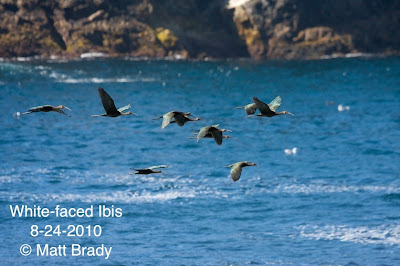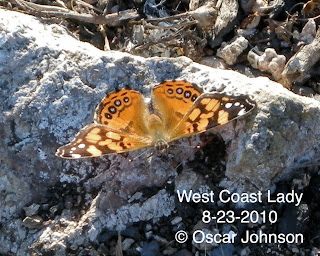The transition from the Summer Seabird breeding season to the Fall migration period always comes during the second half of August. With the field crew change, so too do changes come over the Island. The breeding birds are finishing up their nesting activity, while seal pups born in June and July are quickly gaining weight. The alternating days of wind and sun and socked-in fog that generally characterize the summer season start to give way to calmer weather and high overcast typical of fall. Northern-breeding species of birds have begun their southbound migration; many stop off to visit the Farallones on their way to warmer wintering grounds.
The fall migration crew this year consists of biologist Jim Tietz, out for his ninth fall season, Matt Brady, back for his sixth fall, and Oscar Johnson, a Farallon rookie. We joined Jessie Beck, a seabird intern that will be staying with us until mid-September, to continue monitoring any lingering breeding seabirds. Our arrival on August 21st was uneventful, though one of the first landbirds we saw was a Least Flycatcher at the Heligoland Tree (the one Monterey Pine on the Island). It’s always great to start the season off with a vagrant!
Variable light-to-strong northwest winds prevailed during our first week on the Island. Although these winds tend to keep migrants onshore, a few did manage to come out for a visit. Notable were several Blue Grosbeaks, including four together, an early-ish Hermit Warbler, a family of Greater White-fronted Geese, three Long-eared Owls, and a few Sabine’s Gulls seen during seawatches. Oddly, despite being a relatively common bird in the Southwest, there are fewer records of Blue Grosbeak for the Island than there are of Least Flycatcher!
We set up mist-nets at the Rixford and Coast Guard trees, in anticipation of catching and banding migrants, but to date the weather has not allowed us to open the nets much. Not only is this because high winds are not conducive to catching birds, but also because the strong northwest winds have kept birds away from the Island, so there have simply not been many birds to catch. However, we have managed to catch a few birds. The most exciting of these came on the first day we opened nets, when we caught one of the Long-eared Owls. Luckily, we had locking size-5 bands (big bands, much larger than the bands we use for songbirds), so we were able to band it, and now we look every day for our banded owl!

A few migrant insects rode some of the lighter winds out to the Island. The most exciting was a Gray Hairstreak butterfly that Oscar found resting on a Lavatera bush on the 24th. This species was last seen on the Island 7 years ago. Other, more expected insects included several Black Saddlebags, Blue-eyed Darners, and a number of Variegated Meadowhawks (all dragonflies), as well as daily counts of West Coast Ladies (butterfly) in the range of 7-15 individuals. Another unusual species of insect came with two Blue Dashers, a species of dragonfly that had, until 2008, only been seen once before on the Island; there are now about six records for the Island.
Although the bulk of migration has yet to come, we’ve found a few vagrants aside from the Least Flycatcher. During a lull in the howling northwesterlies of recent days, a young female Blackburnian Warbler making her first journey south paid the Island a short visit, while an American Redstart made an even-more brief pause at the Lighthouse. A skittish Lark Bunting lurked on the Terrace for two days as well. Although on the early side of things, these three species are regular during fall migration. Late August is a good time to hope for a truly rare bird or two also. Two such species did grace the Island briefly. On the 29th of August, Oscar found a small, green-backed hummingbird that, after giving us some quick looks as it drank from some flowering Lavatera, we determined was the Island’s sixth-ever Ruby-throated Hummingbird! After capturing the bird in one of our mist-nets and examining it in-hand, we were able to confirm the identity with 100% certainty, a rare claim indeed for California. Coincidentally, this was not the first Ruby-throated Hummingbird for California this year. One was seen at Keith Hansen’s Wildlife Gallery in Bolinas, Marin County, for a few days at the beginning of the month. Even the rarity of the elusive Ruby-throated Hummingbird, however, was no match for the show-stopping flock of White-faced Ibis that circled the Island several times on the 24th! While mainland birders may scoff at ibis in the face of a Ruby-throated Hummingbird, Faralloners know that, from an Island perspective, ibis are among the rarest of species to ever occur on the Island, in the company of such outstanding birds as Red-flanked Bluetail, Common Rosefinch and Golden-cheeked Warbler. Why might this be? Because, up until the 24th, there was only one modern record of White-faced Ibis, a single bird, seen in 1998! So far, Fall Season 2010 is shaping up to be a fantastic fall. Stay tuned for more vagrants!




In addition to the more sought-after vagrants, we have number of other interesting, or just plain photogenic birds and mammals around the island in the past week.
<><><><><><><><><><><><><><>
<>

 | <><><><><><><><><><><><><><>
Although Ring-billed Gulls are one of the more common gull species on the mainland, they are an uncommon species offshore, and therefore also uncommon on the Farallon Islands. This individual, a juvenile, is a somewhat early fall arrival. |
 |
Occasionally we get California Gulls with field-readable color bands. This individual came from San Francisco Bay, but we also get individuals from Mono Lake.
|
This is one of the many bleached hatch-year California Gulls that show up on the island. We suspect that many of these are from Mono Lake, which is supported by the fact that the two Mono Lake birds that we have found show this bleached plumage. |
|
 |
Although not a particularly exciting bird anywhere in California, Eurasian Collared-Dove only showed up on the Farallon Islands for the first time in 2006. A pair of these birds spent the whole summer here this year for the first time. Will they breed next year? |

 |
Thankfully for us, these photogenic birds have been particularly common on the island this year. Our surveys over the past few weeks have indicated that their nesting activity has increased. |
|
<><><><>
<>

In addition to the expected west coast subspecies leutescens, we also get a few of the gray-headed Great Basin subpecies orestera. This individual stuck around for about a week as it molted into formative plumage. | <><>
 |
"My, what pointy teeth you have!" Although Steller Sea Lions are larger and tend to dominate California Sea Lions, Stellers numbers are dwindling along the West Coast. Several causes have been attributed to their decline including environmental changes in the North Pacific, overfishing, and pollution. California Sea Lion numbers, on the other hand, expanded rapidly over the last few decades following passage of the Marine Mammal Protection Act in 1972. |







































